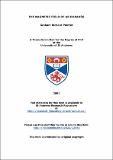Files in this item
The magnetic field of AB Doradûs
Item metadata
| dc.contributor.advisor | Cameron, A. C. | |
| dc.contributor.author | Pointer, Graham Richard | |
| dc.coverage.spatial | xiii, 105 p. | en_US |
| dc.date.accessioned | 2018-03-14T14:08:59Z | |
| dc.date.available | 2018-03-14T14:08:59Z | |
| dc.date.issued | 2001 | |
| dc.identifier.uri | https://hdl.handle.net/10023/12940 | |
| dc.description.abstract | Observations of AB Doradus, a nearby, rapidly-rotating K0 dwarf are analysed, and the surface magnetic field is shown to be approximated by a potential field. Evolving the surface magnetic field according to diffusion and the observed differential rotation still yields good correlation between the calculated and observed radial field after 30 days, contradictory to the results of Barnes et al. (1998), leading to the conclusion that there is an additional cause for the evolution of the magnetic field. The chromospheric magnetic field is modelled as a potential field with a source surface. Using the stability criteria g.B = 0 and B.V(g.B) < 0, places where prominences can be stable are investigated. For agreement with the results of Donati et al. (2000)- that prominences form preferentially near the equatorial plane and at and beyond corotation- it is necessary to add a quasidipolar field of maximum strength ~20G. | en_US |
| dc.language.iso | en | en_US |
| dc.publisher | University of St Andrews | |
| dc.subject.lcc | QB843.D9P7 | |
| dc.subject.lcsh | Dwarf stars. | en |
| dc.subject.lcsh | Stars--Magnetic fields. | en |
| dc.title | The magnetic field of AB Doradûs | en_US |
| dc.type | Thesis | en_US |
| dc.type.qualificationlevel | Doctoral | en_US |
| dc.type.qualificationname | PhD Doctor of Philosophy | en_US |
| dc.publisher.institution | The University of St Andrews | en_US |
This item appears in the following Collection(s)
Items in the St Andrews Research Repository are protected by copyright, with all rights reserved, unless otherwise indicated.

